News
Spring 2021 Update & Reflection
Date: April 11, 2021
This is a belated update! On a personal note, I spent much of 2019 working on a university spinoff venture related to a new e-publishing platform, and then most of 2020 catching up with teaching and other employment to recover from that start-up. Covid and the civic events of 2020 also gave me pause to listen and reflect to the pain many are feeling.
Meanwhile, the older HistoryQuant and History Dynamics sites have been consolidated into the H1st0ry.org site. Yes, that is with a “1” and a “0”.
Like the earlier sites, H1st0ry.com concerns the development of a unified, quantitative science of human history. There have been some extremely critical statements about the creation and utilization of science and mathematics. However, the invention and development of math and science have been neither monocultural nor mono-racial. Peoples and cultures from across the globe and throughout the course of history have made original discoveries and breakthroughs. The ancient great pyramids and structures of Asia, Africa and the Americas were not made through physical effort alone but from equally amazing edifices of math and science. Although math and science have been used at times by European cultures to facilitate oppression, neither are exclusively European or oppressive. They are the shared heritage and domain of all humans.
The relationship between history studies and sustainability is likewise complicated. History expresses stories of sustainability over centuries and millennia. A truly sustainable human society arguably requires a fundamental understanding of historical processes. Unfortunately, the term sustainability has been used to advocate preservation of resources in often inequitable ways. Historical research should not turn a blind eye to impacts on inequities in sustainability advocacy.
So what progress has been by this endeavor over the past few years?
- Machine learning is being applied to study and compare multiple dynasties. (Results will be presented at the 2021 WHA Annual Meeting).
- HIST 305, a digital history course (including quantitative and physical components) was created in Autumn 2019 and taught at San Francisco State University. Many of the materials for that course are available at Digital History.
- Further educational materials have been placed at Digital, Quantitative and Physical History.
- Research has been conducted into the thermodynamic roots of economics.
- Analytical, spatial, and other digital techniques have been used to study the migration of nomads across central Asia and Eastern. Whimsical, exploratory simulation (as shown in the figure below), but more specific, realistic simulations are being conducted as well.
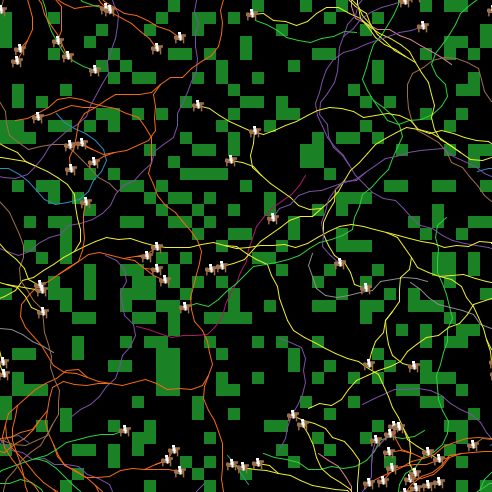
Simulation of nomadic riders across a grassy region
Presentation to Emergy Systems at U of Florida
Date: August 23, 2018
A presentation on Emergy and efficiency analysis of historical bubbles was made at the 10th Biennial Emergy Research Conference, Emergy Synthesis 10, held at the University of Florida in Gainesville, FL, on January 25-27, 2018.
The concept of emergy is essentially the amount of available energy that has been used up to create a present quality of available energy. For example, to produce coal that can be burnt in a power plant, the coal was likely dug out by petroleum-consuming mining equipment, and transported by a petroleum-consuming train. In turn, that petroleum required a lot of energy for exploration, drilling, refining and transport to the mining equipment. Emergy comprises the sum of these energy inputs rather than the available energy in, say, a ton of coal itself. Emergy is useful in studying the flows and consumption of energy in a wide range of systems from swamp ecosystems to the global economy.
If less emery is utilized to produce one ton of coal than another, then one could say that the production process for that one ton of coal was more efficient that the process to produce the second ton of coal. Since the analysis of dynastic and economic bubbles involves efficiency, the emergy approach is of special interest to physical and quantitative history.
Emergy Synthesis 10
Publication: Navigating the Currents of History
Date: March 29, 2018
This piece is part of a forum on Organizing World History in World History Connected organized by Rick Szostak of the University of Alberta.
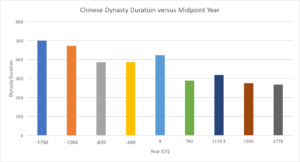
Duration of Chinese dynasties versus time
“Navigating the Currents of History” (World History Connected, University of Illinois Press, February 2018) represents an attempt to create a generic, but unified conceptual language to describe a broad range of phenomena, ranging from history to the geosciences. The goal such an effort is to make it easier to compare diverse phenomena to recognize similarities and also to develop a deeper understanding of the fundamental principles that unify these diverse areas.
Update—Winter 2018
Date:
(It has been over a year since the last update, but I needed to temporarily reduce activities to spend more time dealing with family health issues. Hence the update hiatus.)
Summary
There have been two areas of special effort. The first is to develop a generic but unified language that describes a broad range of phenomena, ranging from history to planetary processes. The second is to delve further into physical and geographic data and analysis.
Recent work has focused upon entering more data into the Colossus world history simulator and analyzing the relations between additional dynasties.
Presentations
- “The Colossus History Grid: integrating network and spatial models of world history,” Annual Meeting of the Social Science History Association—Beyond Social Science History: Knowledge in an Interdisciplinary World, Chicago, Illinois, 17-20 November 2016
- “Lessons About Historical, Economic and Resource Bubbles from the Rise and Fall of Spain’s Golden New World,” World History Association Annual Conference, Boston, Massachusetts, 22 – 24 June 2017.
- “Workshop: Feeding Empires—Quantitative, Digital & Graphic Simulations for History Using Food Cases,” World History Association Annual Conference, Boston, Massachusetts, 22 – 24 June 2017.
- “Emergy and Efficiency Analysis of Historical Bubbles,” 10th Biennial Emergy Research Conference, Gainesville, Florida, January 25-27 2018.
Update—Mid 2016
Date: May 15, 2016
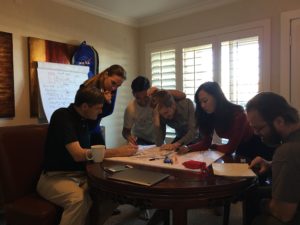
Winter Institute 2016, San Diego
It has been several months since the last update, but work has been continuing in several areas.
Research
HistoryQuant continues to conduct research in the following areas.
- Several forms of differential equations have been developed for efficiency discounted exponential growth (EDEG). Although some of these equations are not be directly solvable, they are be iteratively processed by computer programs, so results can still be determined.
- Am improved EDEG model has been produced to model mining region production and applied to a revised model for the Colorado San Juans mining region.
- Colossus Model of World History: a computer simulation using an EDEG approach has been further developed to model major dynasties during 1600 BCE to 1917 CE. Additional dynasties have been added. The timing of the dynasties is still highly empirical, but the rise and fall are based upon growth discounted by a linear discount function.
- Microeconomics is being expressed in thermodynamic terms. This will help better analyze dynasties and economic bubbles.
- Other areas of research are underway, and will be reported when further results are available. They include: 1) production-consumption functions for exhaustible resources, 2) transitions from exhaustible resource economies to renewable resource economies, and 3) Dynasty structure
Community and Winter Institute
- The development of a science of history and society was presented and discussed extensively at a Winter Institute in January-February 2016 with sessions in Florida and California, in part, to discuss key aspects of developing a science of history. The Big Sustainability Institute was formed as a result of those discussions to apply the results of HistoryQuant work to sustainability challenges.
- If you wish to be added to the Big Sustainability announcement list, please email mpaciotola at gmail dot com
Conference Presentation
- A case study based upon an efficiency-discounted exponential growth model for the Colorado San Juans mining region was updated and presented at the Richard Robinson Business History Workshop 2016: “Business and Environment in History: Dealing in Nature and Ecology, Pasts and Futures” at Portland State University in April.
Dynasty Power Simulations Available!
Date: December 18, 2015
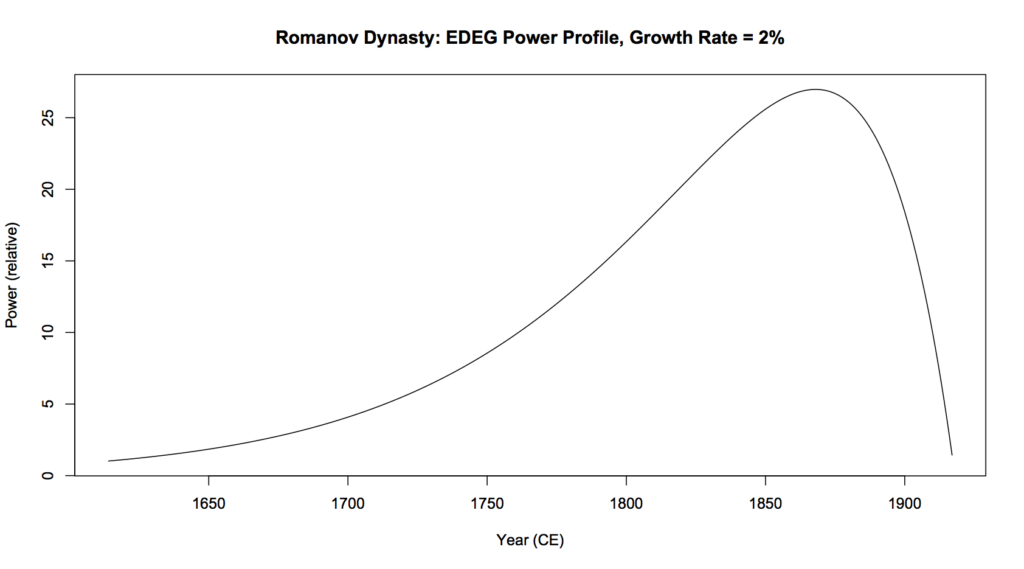
Romanov dynasty power profile
HistoryQuant can use its unique simulators to generate a power models of your favorite historical dynasty using techniques derived from thermodynamics. Large, independent, robust dynasties work best.
For more information about the general approach, see http://arxiv.org/abs/1411.4739 (with the understanding that the methodology has been somewhat updated since that paper).
The HistoryQuant workflow:
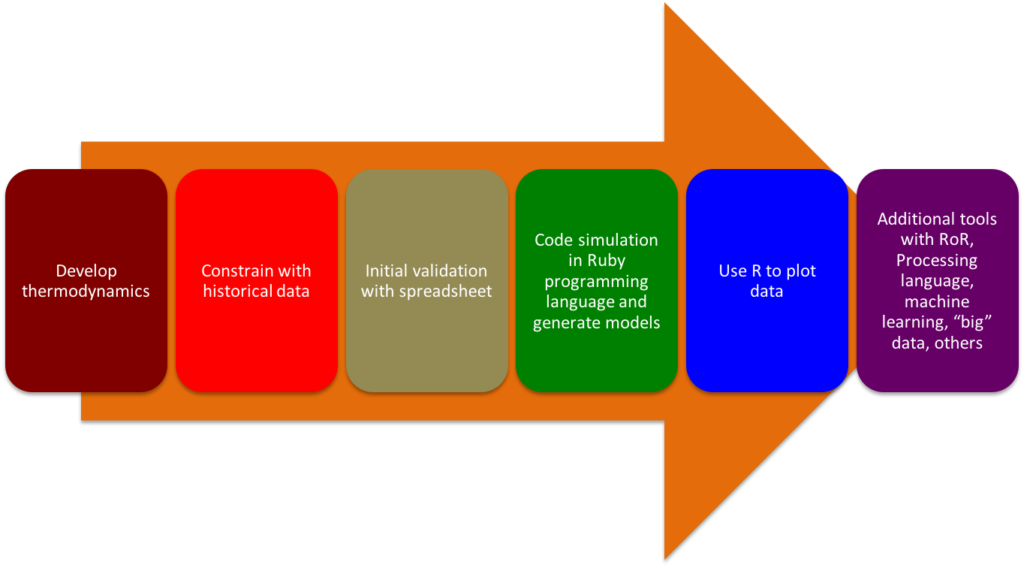
History lab workflow
Wake-Up Call: Technologists’ Take of History Coming to HBO
Date: May 9, 2015

Letter to the American History Association Perspectives magazine regarding how Interstellar’s screenwriter Jonathan Nolan recently announced that he is developing an HBO series to adapt science fiction author Isaac Asimov’s Foundation novels, and how the history community should work before the showing to prevent misconceptions, and to guide increased interest in history into channels where it can be most effective and beneficial.
News from the 2015 AHA Annual Meeting
Date: January 3, 2015

The 2015 AHA Annual Meeting demonstrated the rapid influx of digital technology and even the “hard” sciences into the realm of historical research. Sessions of particular interest included The Resurgence of Science in Historical Method and History and Biology: History and Evolution. Such has not been without controversy, as demonstrated by Ethan Kleinberg’s talk Just the Facts: The Fantasy of a Historical Science. There were too many digital humanities sessions to mention here.
Mark Ciotola gave a lightning talk on Developing Ruby Programming Simulations for History and Using R for Visualization. Relevant links follow:
Requirements of a Science of History
Date: November 26, 2013
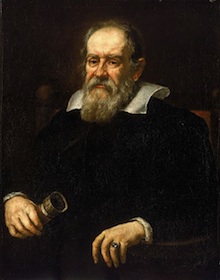
Galileo Galilei by Justus Sustermans
The physical sciences have advanced so far due to the utilisation of the scientific method and their unified nature.
In the scientific method, a hypothesis can be quantitatively tested and rejected rather than relying upon anecdote and informal observation. Using the scientific method, Galileo was able to establish that all objects fall to the surface of the Earth at the same rate, regardless of their mass, unless a counterforce such is present, such as atmospheric drag. This was counterintuitive, and flew in the face of contrary longstanding conclusions made by Aristotle and others.
The scientific method is necessary but not sufficient to develop a really powerful science of history. Social sciences such as sociology already use the scientific method in many cases. Yet those sciences remain highly disjointed, and relatively ineffectual.
The unified nature of the physical sciences (engineering, and to some extent the natural sciences) is an under-appreciated but vitally important source of their effectiveness. The demonstration by Isaac Newton that phenomena in both space and on the Earth were subject to the force of gravity was the cornerstone of this unification. Previously, terrestrial and celestial phenomena were treated as being subject to separate sets of laws.
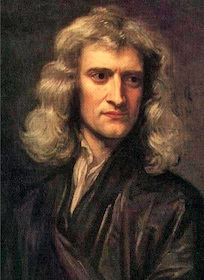
Isaac Newton by Godfrey Kneller
In the unified physical sciences, a hypothesis must produce results that are consistent with the generally accepted principles of physics. It is expected that a hypothesis in the atmospheric sciences will be consistent with the known laws of thermodynamics, such as conservation of energy. When a hypothesis is inconsistent with the laws of physics and cannot be refuted using observational evidence, then the laws of physics must be changed. A principle in astronomy can hence be related and constrained by a principle in geology. Since the laws of physics are invariant across time and space, a planet around the Sun follows the same laws as a planet around a distant exoplanet.
To be truly effective, a science of history must be unified within itself. One principle must be consistent with another. This will be bitter pill to swallow for armchair kings and emperors who savor multiple theories and fought over them with ferocious enjoyment and indignant delight.
The pill gets more acerbate. To approach the effectiveness exercised by the physical sciences, a science of history must also be unified with the laws of physics. If so, historical phenomena must be constrained by physical laws such as the conservation of mass and energy. This is a controversial proposition, and not likely to be accepted without an overwhelming amount of supporting evidence and the passing of time.
In summary, for a science of history to approach the effectiveness of the physical science, it must use the scientific method, be unified within itself, and be unified with the laws of physics.
Links Page Provides Brief Survey of Science of History Field
Date: November 15, 2013
The Links page serves as a brief survey of endeavours related to the new science of history.
- Research: several groups are featured from Australia, Europe and North America with approached ranging from ecological to thermodynamic approaches.
- Data: most approaches need more of it, and the data source projects listed are mostly new and under development. Even Wikidata, which is the furthest along, is only about a year old. Wolfram Alpha is perhaps the most established.
- Journals: the few that exist so far are of varied quality, but express vanguard of this field.
- Tools and Software: there aren’t many tools specifically designed for this science yet, but there is an open source cellular automata program and several free simulations. More will be coming.
- Outreach: a link to Big History media end the links on a fun, cosmic note.
H1st0ry.org will post news, articles and reviews about many of these endeavors and tools, and analyze how they all fit together. If any vital links have been missed, please tell the Editor!








